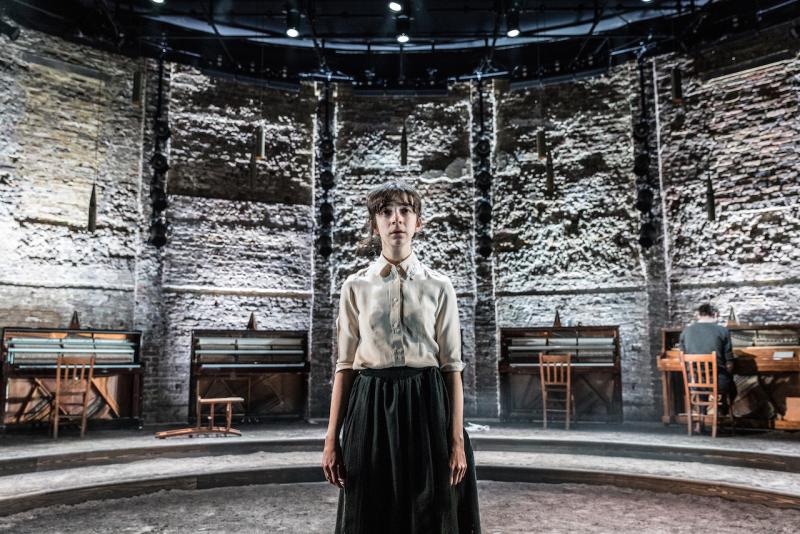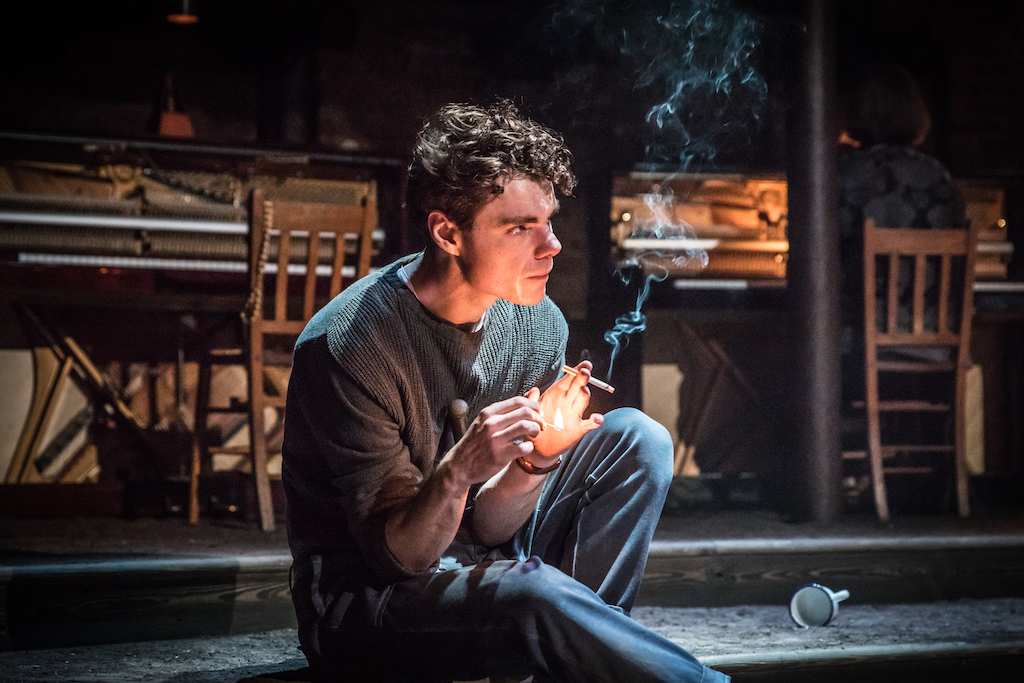Summer and Smoke, Duke of York's Theatre review – Patsy Ferran's remarkable performance | reviews, news & interviews
Summer and Smoke, Duke of York's Theatre review – Patsy Ferran's remarkable performance
Summer and Smoke, Duke of York's Theatre review – Patsy Ferran's remarkable performance
West End transfer from the Almeida retains pressure-cooker intensity

This production of Tennessee Williams’ neglected classic, Summer and Smoke, arrives from the Almeida into the West End with five-star plaudits for its pitch-perfect performances and pressure-cooker intensity.
It is a pleasure to be able to report, therefore, that Rebecca Frecknall’s boldly expressionist production – with its electrifying soundscape – galvanises the audience from the start. Seven upright pianos, their strings and hammers exposed like animals’ innards, stand in a semi-circle at the back of the stage. From the shadows, performers emerge to create an urgent, hammering refrain that builds in intensity as a woman standing at a microphone gulps and hyperventilates her way through panic that seems to rock her like an earthquake.
It’s the first moment that you realise that, for all its fine ensemble work, this evening is going to be defined by a quite remarkable performance from Patsy Ferran as the uptight minister’s daughter, Alma Winemiller. Summer and Smoke is not subtle symbolically – the name Alma means "soul" while John, the young dissolute doctor’s son with whom she falls in love, worships anatomy both in and out of textbooks – yet Ferran’s raw sensitivity ensures every note rings true.
We are all essentially living inside Alma's head
That’s not least due to the physical comedy that she extracts from her character being as tense as a piano wire. When Matthew Needham’s lanky, drawling doctor’s son (pictured below) identifies Alma as a hysteric, her indignation contorts her, when she giggles, it sounds like there are solid bubbles in her throat. Her arms, clamped stiffly to her sides, seem hinged sharply at the elbows as her hands fly around like panicked birds, while her face, when she is dismayed, radiates both bleak beauty and comic desolation.
Yet we are moved by her throughout, and that’s not just because Frecknall’s brilliant expressionist twist means we are all essentially living inside Alma’s head. It’s also due to our being able to see that she is attracted to John not despite his being her opposite, but precisely because he is her opposite. One of the most incandescent moments – where lighting and sound design fuse perfectly with the play’s emotions – is when Alma and John, teetering dangerously on the verge of cliché, watch a firework display together. The potential absurdity is beautifully offset by other cast members recreating the whistle of the fireworks, before an explosion of sound is matched by an explosion of light within the pianos, and the physical impact resonates on a whole other level. Both Alma and John are buckled under the weight of parental expectations – Alma by her demanding clergyman father, who needs her as a substitute spouse now his wife is mentally ill, and John by a father who is an idealistic doctor. It’s a great bit of double casting, then, to make Forbes Masson play both men as different kinds of emotional tyrants, equally responsible for their children’s insecurities. Nancy Crane also distinguishes herself as Alma’s mother, made simultaneously decadent and spiteful by her dementia. And in another example of clever multiple casting, Anjana Vasan compellingly embodies the confident sensuality of the women in John’s life who act in counterpoint to Alma’s buttoned-up virginity.
Both Alma and John are buckled under the weight of parental expectations – Alma by her demanding clergyman father, who needs her as a substitute spouse now his wife is mentally ill, and John by a father who is an idealistic doctor. It’s a great bit of double casting, then, to make Forbes Masson play both men as different kinds of emotional tyrants, equally responsible for their children’s insecurities. Nancy Crane also distinguishes herself as Alma’s mother, made simultaneously decadent and spiteful by her dementia. And in another example of clever multiple casting, Anjana Vasan compellingly embodies the confident sensuality of the women in John’s life who act in counterpoint to Alma’s buttoned-up virginity.
Although the evening teeters on tragedy – one of its most extraordinary moments, beautifully lit by Lee Curran, is when John’s father is fatally shot – we are allowed to see Alma’s turbulent journey end with a whisper of redemption. It’s just one high note in a complex symphony of emotion that shows us that, for all John’s emphasis on anatomy, it’s as ever the inexplicable aspects of the human heart that are truly transformative.
- Summer and Smoke at the Duke of York's Theatre till 19 January 2019
- Read more theatre reviews on theartsdesk
rating
Explore topics
Share this article
The future of Arts Journalism
You can stop theartsdesk.com closing!
We urgently need financing to survive. Our fundraising drive has thus far raised £49,000 but we need to reach £100,000 or we will be forced to close. Please contribute here: https://gofund.me/c3f6033d
And if you can forward this information to anyone who might assist, we’d be grateful.

Subscribe to theartsdesk.com
Thank you for continuing to read our work on theartsdesk.com. For unlimited access to every article in its entirety, including our archive of more than 15,000 pieces, we're asking for £5 per month or £40 per year. We feel it's a very good deal, and hope you do too.
To take a subscription now simply click here.
And if you're looking for that extra gift for a friend or family member, why not treat them to a theartsdesk.com gift subscription?
more Theatre
 Othello, Theatre Royal, Haymarket review - a surprising mix of stateliness and ironic humour
David Harewood and Toby Jones at odds
Othello, Theatre Royal, Haymarket review - a surprising mix of stateliness and ironic humour
David Harewood and Toby Jones at odds
 Macbeth, RSC, Stratford review - Glaswegian gangs and ghoulies prove gripping
Sam Heughan's Macbeth cannot quite find a home in a mobster pub
Macbeth, RSC, Stratford review - Glaswegian gangs and ghoulies prove gripping
Sam Heughan's Macbeth cannot quite find a home in a mobster pub
 The Line of Beauty, Almeida Theatre review - the 80s revisited in theatrically ravishing form
Alan Hollinghurst novel is cunningly filleted, very finely acted
The Line of Beauty, Almeida Theatre review - the 80s revisited in theatrically ravishing form
Alan Hollinghurst novel is cunningly filleted, very finely acted
 Wendy & Peter Pan, Barbican Theatre review - mixed bag of panto and comic play, turned up to 11
The RSC adaptation is aimed at children, though all will thrill to its spectacle
Wendy & Peter Pan, Barbican Theatre review - mixed bag of panto and comic play, turned up to 11
The RSC adaptation is aimed at children, though all will thrill to its spectacle
 Hedda, Orange Tree Theatre review - a monument reimagined, perhaps even improved
Scandinavian masterpiece transplanted into a London reeling from the ravages of war
Hedda, Orange Tree Theatre review - a monument reimagined, perhaps even improved
Scandinavian masterpiece transplanted into a London reeling from the ravages of war
 The Assembled Parties, Hampstead review - a rarity, a well-made play delivered straight
Witty but poignant tribute to the strength of family ties as all around disintegrates
The Assembled Parties, Hampstead review - a rarity, a well-made play delivered straight
Witty but poignant tribute to the strength of family ties as all around disintegrates
 Mary Page Marlowe, Old Vic review - a starry portrait of a splintered life
Tracy Letts's Off Broadway play makes a shimmeringly powerful London debut
Mary Page Marlowe, Old Vic review - a starry portrait of a splintered life
Tracy Letts's Off Broadway play makes a shimmeringly powerful London debut
 Little Brother, Soho Theatre review - light, bright but emotionally true
This Verity Bargate Award-winning dramedy is entertaining as well as thought provoking
Little Brother, Soho Theatre review - light, bright but emotionally true
This Verity Bargate Award-winning dramedy is entertaining as well as thought provoking
 The Unbelievers, Royal Court Theatre - grimly compelling, powerfully performed
Nick Payne's new play is amongst his best
The Unbelievers, Royal Court Theatre - grimly compelling, powerfully performed
Nick Payne's new play is amongst his best
 The Maids, Donmar Warehouse review - vibrant cast lost in a spectacular-looking fever dream
Kip Williams revises Genet, with little gained in the update except eye-popping visuals
The Maids, Donmar Warehouse review - vibrant cast lost in a spectacular-looking fever dream
Kip Williams revises Genet, with little gained in the update except eye-popping visuals
 Ragdoll, Jermyn Street Theatre review - compelling and emotionally truthful
Katherine Moar returns with a Patty Hearst-inspired follow up to her debut hit 'Farm Hall'
Ragdoll, Jermyn Street Theatre review - compelling and emotionally truthful
Katherine Moar returns with a Patty Hearst-inspired follow up to her debut hit 'Farm Hall'
 Troilus and Cressida, Globe Theatre review - a 'problem play' with added problems
Raucous and carnivalesque, but also ugly and incomprehensible
Troilus and Cressida, Globe Theatre review - a 'problem play' with added problems
Raucous and carnivalesque, but also ugly and incomprehensible

Add comment